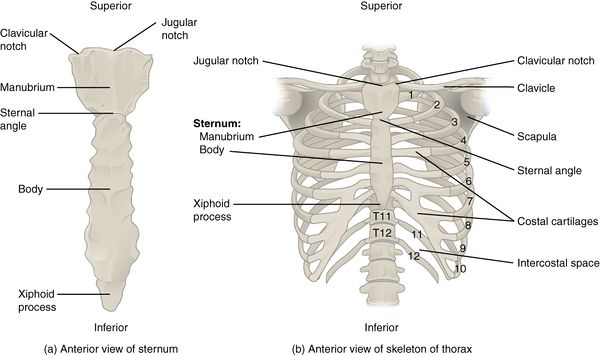Ribs
This article or area is currently under construction and may only be partially complete. Please come back soon to see the finished work! (14/04/2020)
Original Editor - Your name will be added here if you created the original content for this page.
Top Contributors - Lucinda hampton, Kim Jackson and Joao Costa
Introduction[edit | edit source]
The ribs are the bony framework of the thoracic cavity.
- The ribs form the main structure of the thoracic cage protecting the thoracic organs, however their main function is to aid respiration.[1]
- There are twelve pairs of ribs.
- Each rib articulates posteriorly with two thoracic vertebrae by the costovertebral joint. An exception to this rule is that the first rib articulates with the first thoracic vertebra only.
According to their attachment to the sternum, the ribs are classified into 3 groups: true, false, and floating ribs.
- The true ribs are the ribs that directly articulate with the sternum with their costal cartilages - ribs 1-7. They articulate with the sternum by the sternocostal joints. The first rib is an exception to that rule; it is a synarthrosis and the first rib could uniquely articulate with the clavicle by the costoclavicular joint
- The false ribs (8,9,10) are the ribs that indirectly articulate with the sternum, as their costal cartilages connect with the seventh costal cartilag by the costochondral joint.
- The floating ribs (11,12) do not articulate with the sternum at all (distal two ribs).[2]
Structure and Function[edit | edit source]
Typically, the ribs have the following anatomical components:
- Head with two articular facets
- Tubercle
- Neck
- Shaft
- Costal groove
Most of the ribs are typical ribs ie they have all these features. The atypical ribs which do not have all these features are:
- First rib (wide and short, has two costal grooves, and one articular facet)
- Second rib (thin, long, and has a tuberosity on its superior surface for the attachment of the serratus anterior muscle)
- Tenth rib (only one articular facet)
- Eleventh rib, Twelfth rib (one articular facet with no neck)
The functions of the ribs are critical, as they
- protect the contents of the thoracic cavity and mediastinum
- move superiorly, inferiorly, anteriorly and posteriorly to facilitate breathing (their flexibility in their movement increases/decreases the size of the thoracic cavity; assisting the lungs in respiration. Control of these movements is via the diaphragm, external intercostals, and the intercartilaginous portion of the internal intercostals).
- provide a place where some muscles originate or attach
- play a role in erythropoiesis during development (at birth, the erythropoiesis sites change, it recedes in long bones and persists in flat bones, like ribs)[2]
Sub Heading 2[edit | edit source]
Sub Heading 3[edit | edit source]
Resources[edit | edit source]
- bulleted list
- x
or
- numbered list
- x
References[edit | edit source]
- ↑ Radiopedia Ribs Available from:https://radiopaedia.org/articles/ribs (last accessed 14.4.2020)
- ↑ 2.0 2.1 Safarini OA, Bordoni B. Anatomy, Thorax, Ribs. InStatPearls [Internet] 2019 Feb 19. StatPearls Publishing.Available from:https://www.ncbi.nlm.nih.gov/books/NBK538328/ (last accessed 14.4.2020)







